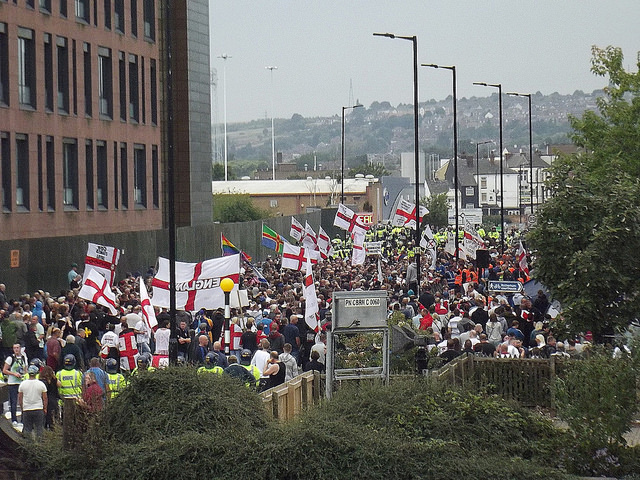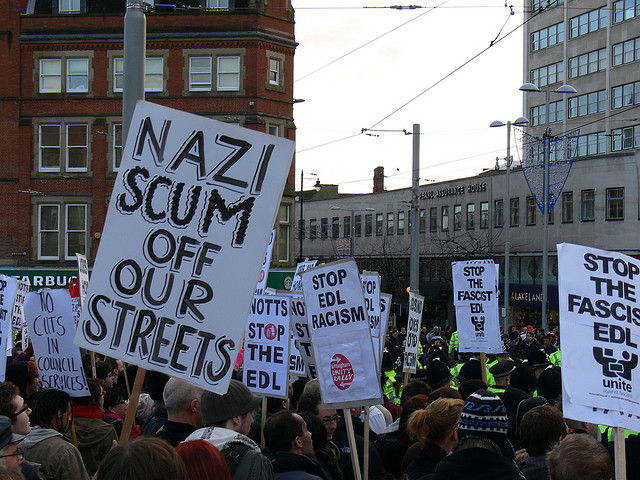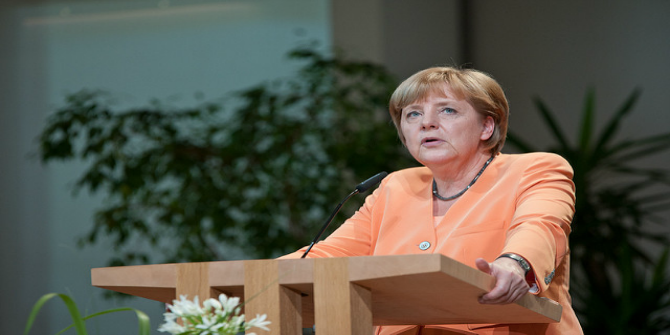 Joel Busher reflects on what his 16 months of ethnographic fieldwork with the English Defence League tells us about what distinguishes them from the ‘ordinary English people’ that they claim to represent. His research highlights the importance of linking the attitudes and ideology of EDL activists with their lived experience, and questions what role society at large plays in shaping that experience.
Joel Busher reflects on what his 16 months of ethnographic fieldwork with the English Defence League tells us about what distinguishes them from the ‘ordinary English people’ that they claim to represent. His research highlights the importance of linking the attitudes and ideology of EDL activists with their lived experience, and questions what role society at large plays in shaping that experience.
When I started spending time with EDL activists, one of the things that struck me was how relatively ‘normal’ most of the people I met seemed to be. There can be little doubt that some had been attracted by the prospect of ‘kicking off’ and engaging in violence; on several occasions I saw the clichéd images of angry, shaven-headed, heavily-tattooed men, with noses sculpted by years of confrontation, shouting and snarling at their opposition, at the police, and into media cameras. Yet other activists I met found violent incidents and public disorder at demonstrations unnerving, stressful, and even traumatic. In fact, I soon discovered that a good deal of the tension bubbling away at the grassroots of the movement related to differences of opinion about where and when violence was and wasn’t acceptable, and what should be done about those who violated these unwritten rules.
EDL march in Rotherham, 2014 (Credit: Chris CC BY 2.0)
Similarly, while some activists I met undoubtedly used the EDL to pursue long-held and overtly racist agendas, many others persistently avoided such discourses and clung fiercely to claims that they were ‘not racist, not violent, just no longer silent’ – a popular EDL slogan. Particularly once we were sat somewhere away from the adrenaline high and ritualised bravado of their street demonstrations, there was often little obvious difference between many of their ideas and anxieties and those expressed by many thousands, indeed probably millions, of people across the UK who are concerned about issues of immigration, integration and security and have increasingly come to associate these issues cognitively and emotionally with Islam.
What distinguished the EDL activists I knew from the wider pool of people who might share similar anxieties was the extent to which these issues, and their associated feelings of fear, anxiety, anger, pride and hate, had come to dominate their lives. ‘Militant Islam’ and the prospect of ‘Islamisation’ were not things just to grumble about down the pub or to their mates on Facebook, although they did this as well. Most of the activists I knew had also developed a quite real sense that they were living their lives on the ‘front line’ of an imagined ‘clash of civilisations’.
How did this happen? I would propose that there were two dimensions to this process: a narrative/ideological dimension and a lived/experiential dimension. By engaging with the materials circulated within the activist community – various blogs, websites, news articles and a steady stream of broadly anti-Muslim propaganda – and exchanging ideas with fellow activists, they acquired and increasingly saw the world through a set of concepts about the supposed incompatibility of Islamic and Western cultures. They also picked up phrases such as ‘two-tier system’ (used to connote a systemic bias against ‘ordinary English people’) and ‘cultural Marxism’ (used to invoke ideas of nefarious leftist influence over British and Western public life). When tagged onto the end of any number of stories, these phrases could transform them from anecdotes into evidence and explain the perceived injustice of the world around them.
What gave these ideas such traction was the way they intersected with, and gained relevance through, activists’ everyday experiences. As people engaged with the group, EDL issues became personal issues. New recruits quickly met and formed bonds of friendship and solidarity with people who themselves identified as victims of ‘militant Islam’, the ‘two-tier system’ of British justice, etc. – EDL activists who claimed they had been mistreated by the police, activists whose children had been killed fighting in Iraq or Afghanistan and so forth. It was no longer simply a soldier who had been killed by the Taliban, but ‘my mate’s son’.
Second, their own lives became increasingly characterised by encounters that served to activate the identities and emotions associated with the EDL cause. Particularly in the London area, where most of my research was carried out, EDL activism brought them into frequent face-to-face contact with some of the most extreme Islamist activists in Europe; entailed regular online and offline clashes with hostile anti-fascist activists; and most soon accumulated their own personal catalogue of grievances about their dealings with the police and government officials. As the activists swapped, circulated and embellished these stories, they spun out a narrative that permeated and transformed their lives – two police cars passing by became state surveillance, a new takeaway on the high-street selling halal food became part of an imagined global terrorist-financing network, a newspaper story about the failure of the government to deport suspected terrorists became a call to action.
If we, as a society, are concerned about organised anti-minority activism and its implications for social relations and security, we would do well to reflect on how our actions shape the process through which people in groups such as the EDL come to believe that they are living on the ‘front line’ of an imagined ‘clash of civilisations’.
Anti-EDL march in Nottingham, 2009 (Credit: David Haywood CC-BY-NC-SA 2.0)
While EDL activists found themselves criticised and shouted down with terms such as ‘racist!’ ‘fascist!’ or ‘Islamophobia!’, they also found what they believed to be their own ideas and arguments played back to them on a regular basis in mainstream political, media and public discourses.
And for some, finding themselves ‘kettled’ or detained for hours by the police with only scant toilet facilities, or being confronted by anti-EDL activists shouting, jeering and even throwing objects at them, might put them off participating in protest. Yet for others this is precisely what gives them the ‘buzz’ of activism, intensifies their feelings of injustice, and makes it increasingly difficult for those within the movement who are in favour of organising legal and largely peaceful protest activities to persuade their co-activists that this is the best course of action.
___
Note: the article represents the views of the author and not those of the British Politics and Policy blog nor of the LSE. Please read our comments policy before posting.
___
 Joel Busher is a Research Fellow at the Centre for Trust, Peace and Social Relations, Coventry University, UK. He is the author of a recent book, The Making of Anti-Muslim Protest.
Joel Busher is a Research Fellow at the Centre for Trust, Peace and Social Relations, Coventry University, UK. He is the author of a recent book, The Making of Anti-Muslim Protest.
Featured Image Credit: (Credit: Chris CC BY 2.0)










I think you’ve tried to understand, but to me, who doesn’t live in England, and knows nothing about the EDL, it is clear that you start from false premices. Basically that different cultures can and should live peacefully together, rather than peacfully apart, each with their own space. Rathlin island is a good example of how they can live peacefully together, the rest of Northern Ireland shows how in practice they live apart.Europe has never hapily tollerated Islamic rule and the middle east has never hapily tolerated Christian rule. Both though have tolerated minorities of the other faith.
Your article ignores the facts.
The islamisation of our country is a fact! Muslim numbers double every 10 yrs for the last 40 years according to UK census figures. English people have become a minority in towns like London, Bradford and Birmingham etc. EVERY year this gets worse and worse. It is the genocide and replacement of the British people in our own country – immigration being the weapon of choice!
People are people but 2 things seperate us that cause conflict namely ideas and behaviour.
Not only Islam as a religion but also the cultures that come with it bring many ideas and exhibit behaviour that MOST British people look at as uncivilised and in direct opposition to our own culture, values and way of life.
The English people have a right to their identity. We have a right to self determination. There is a massive gap between every day people and our corrupt government and the choices it makes. A government / king / dictator etc can only ignore the people for so long before they fight back.
As Muslim numbers increase so will the problems. If you dont have any concerns for our descendants future then you are deluded.
There need to be social programs in-place for dealing with each of the complaints these EDL followers offer. Without such programs societies come un-glued. Britain used to have them: 1950s churches sent young workers out into communities, the brave ones into pubs — local shops were gathering places, customers were known personally — local police walked beats and played grandfatherly roles, knew the names of “their” locals — government agencies of various types invited folks in to small & friendly High Street premises for problem-solving, and even *gasp* went out to “visit” them at pubs, in hospitals, playgrounds, parks, prisons.
But much of that social support has been removed, in the UK: here in the US it’s disappeared entirely — here government is alien, local police cruise in patrol cars and “know” no one, shopping is gone online & Main Street is simply gone, churches are either fringe-extremist-wingnuts themselves or empty.
We both, UK & US, need our social-safety-nets, and some youth employment, back: that’s where those EDL recruits, likewise the ISIS terrorists, come from.